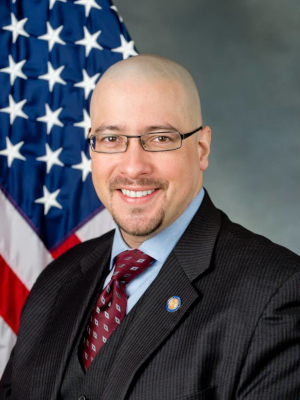2023-06
Automatic Enrollment and Streamlined Renewal in Medicaid
Sponsored by Sen. Gustavo Rivera (NY)
Reported to the Caucus by the NHCSL Healthcare Task Force
Rep. Alma Hernández (AZ), Chair
Unanimously ratified by the Caucus on December 2, 2023.
I. Persons with disabilities, Hispanics and other families of color have a heightened need for streamlined Medicaid enrollment and renewal
WHEREAS, Medicaid eligibility criteria and benefits differ from state to state, but some groups are mandatorily eligible like low-income families, qualified pregnant women and children, and individuals receiving Supplemental Security Income (SSI) or Mandatory State Supplements; [1] and,
WHEREAS, during the Covid-19 pandemic, Medicaid enrollment increased by 29.8% reflecting “changes in the economy, changes in policy (like recent adoption of the Medicaid expansion in the Affordable Care Act), and the temporary continuous enrollment provision created by the Families First Coronavirus Response Act (FFCRA),” which ended on March 31, 2023. The Consolidated Appropriations Act for Fiscal Year 2023 “also phases down the enhanced federal Medicaid matching funds through December 2023;”[2] and,
WHEREAS, experts estimate that, because the pandemic’s continuous enrollment provision has ended, “between 5.3 million and 14.2 million people will lose Medicaid coverage during the 12-month unwinding period reflecting a 5% and 13% decline in enrollment;”[3] and,
WHEREAS, “as states resume redeterminations and disenrollments, certain individuals, including people who have moved, immigrants and people with limited English proficiency (LEP), and people with disabilities, will be at increased risk of losing Medicaid coverage or experiencing a gap in coverage due to barriers completing the renewal process, even if they remain eligible for coverage;” [4] and,
WHEREAS, “a recent analysis of churn rates among children found that while churn rates increased among children of all racial and ethnic groups, the increase was largest for Hispanic children, suggesting they face greater barriers to maintaining coverage;”[5] and,
WHEREAS, according to a KFF review of state Medicaid websites, the following states do not offer either or neither their Medicaid homepage or the online application in any language other than English: Alabama, Alaska, Arkansas, Delaware, Hawaii, Iowa, Kansas, Kentucky, Michigan, Minnesota, Nevada, New Jersey, North Dakota, Ohio, Oregon, South Carolina, Vermont, Washington, West Virginia and Wisconsin;[6] and,
WHEREAS, historically, “among people disenrolling from Medicaid, roughly two-thirds (65%) had a period of uninsurance in the year following disenrollment and only 26% enrolled in another source of coverage for the full year following disenrollment;”[7] and,
II. Streamlined Medicaid enrollment and renewal can be improved
WHEREAS, on September 7, 2022, the Centers for Medicare & Medicaid Services (CMS) proposed a rule, to be finalized on November 2023, to,
inter-word; simplify the processes for eligible individuals to enroll and retain eligibility in Medicaid, the Children's Health Insurance Program (CHIP), and the Basic Health Program. This proposed rule would remove barriers and facilitate enrollment of new applicants, particularly those dually eligible for Medicare and Medicaid; align enrollment and renewal requirements for most individuals in Medicaid; establish beneficiary protections related to returned mail; create timeliness requirements for redeterminations of eligibility in Medicaid and CHIP; make transitions between programs easier; eliminate access barriers for children enrolled in CHIP by prohibiting premium lock-out periods, waiting periods, and benefit limitations; and modernize recordkeeping requirements to ensure proper documentation of eligibility and enrollment; [8] and,
WHEREAS, apart from this proposed rule, states have information they can use to make insurance auto-enrollment and auto-renewal work to protect the most vulnerable; and,
WHEREAS, at enrollment and renewal, tools some states use to fairly assess eligibility and reduce needless churn include accounting for anticipated income changes, such as recurring seasonable employment or a job change, or projected annual income when determining eligibility at renewal,[9] and,
WHEREAS, another important step to prevent needless churn is taking proactive steps to update address information for and other steps to facilitate communication with enrollees,[10] and preventing plan terminations solely based on returned mail;[11] and,
WHEREAS, the gold-standard tool to reduce churn has been 12-month continuous eligibility, which 31 states[12] extend to children in either Medicaid or CHIP, and which Montana and New York also extend to adults under waiver authority,[13] to eliminate coverage gaps due to fluctuations in income over the course of the year. This approach is cost-effective[14] and works best when states do not conduct periodic data matches between the 12-month renewal windows;[15] and,
WHEREAS, to proactively enroll children in Medicaid, a few states (Alabama, Colorado, Iowa, Louisiana, Maryland,[16] Massachusetts, South Carolina and South Dakota) have implemented Express Lane Eligibility, using income tax records or express lane agencies like SNAP, TANF, WIC, Head Start or the School Lunch Program to automatically enroll and renew eligible children in Medicaid;[17] and,
WHEREAS, to minimize friction in care as eligibility is determined when a person seeks care or needs proof of care, some states[18] have implemented presumptive eligibility, which authorizes entities like schools, community-based organizations, hospitals and other qualified entities to determine if the individual qualifies for Medicaid and extends temporary coverage until full eligibility is determined;[19] and,
WHEREAS, but even presumptive eligibility may not benefit those who do not seek care because they are unaware they are potentially eligible, unless it is also folded into a recurring process like filing state income tax returns which could double as an application if the relevant check-box question were included.
THEREFORE, BE IT RESOLVED, that the National Hispanic Caucus of State Legislators urges states to enact legislation that implements accounting for anticipated income changes and projected annual income when determining Medicaid eligibility; and,
BE IT FURTHER RESOLVED, that the National Hispanic Caucus of State Legislators urges states to enact legislation and/or seek the relevant waivers to implement 12-month continuous eligibility in Medicaid for both children and adults; and,
BE IT FURTHER RESOLVED, that the National Hispanic Caucus of State Legislators urges states to enact legislation to implement express lane eligibility using all available agencies, including income tax records; and,
BE IT FURTHER RESOLVED, that the National Hispanic Caucus of State Legislators urges states to enact legislation to implement presumptive eligibility in Medicaid; and,
BE IT FURTHER RESOLVED, that the National Hispanic Caucus of State Legislators urges states to enact legislation to include in all state income tax return forms a question that authorizes checking eligibility for Medicaid and automatic enrollment; and,
BE IT FINALLY RESOLVED, that the National Hispanic Caucus of State Legislators urges states to ensure that their Medicaid websites and online applications are translated into Spanish and into other languages as appropriate.
THE HEALTHCARE TASK FORCE UNANIMOUSLY RECOMMENDED THIS RESOLUTION TO THE EXECUTIVE COMMITTEE FOR APPROVAL. THE EXECUTIVE COMMITTEE UNANIMOUSLY APPROVED THIS RESOLUTION AT ITS MEETING OF APRIL 23, 2023, IN SAN JUAN, PUERTO RICO.
THE NATIONAL HISPANIC CAUCUS OF STATE LEGISLATORS UNANIMOUSLY RATIFIED THIS RESOLUTION ON DECEMBER 2, 2023 AT ITS ANNUAL MEETING IN PHILADELPHIA, PENNSYLVANIA.
[1] For a full list see Medicaid Eligibility. Medicaid.gov. https://www.medicaid.gov/medicaid/eligibility/index.html
[2] Jennifer Tolbert and Meghana Ammula. 10 Things to Know About the Unwinding of the Medicaid Continuous Enrollment Provision. (April 5, 2023, KFF). Available at https://www.kff.org/medicaid/issue-brief/10-things-to-know-about-the-unwinding-of-the-medicaid-continuous-enrollment-provision/
[3] Ibid.
[4] Ibid.
[5] Ibid.,citing Elizabeth Williams, et al, Implications of Continuous Eligibility Policies for Children’s Medicaid Enrollment Churn. (Dec. 21, 2022, KFF). Available at https://www.kff.org/medicaid/issue-brief/implications-of-continuous-eligibility-policies-for-childrens-medicaid-enrollment-churn/
[6]Jennifer Tolbert and Meghana Ammula. 10 Things to Know About the Unwinding of the Medicaid Continuous Enrollment Provision. (April 5, 2023, KFF). Available at https://www.kff.org/medicaid/issue-brief/10-things-to-know-about-the-unwinding-of-the-medicaid-continuous-enrollment-provision/
[7] Ibid.
[8] 87 Federal Register 54760. Available at https://www.federalregister.gov/documents/2022/09/07/2022-18875/streamlining-the-medicaid-childrens-health-insurance-program-and-basic-health-program-application
[9] Bradley Corallo, et al, Medicaid Enrollment Churn and Implications for Continuous Coverage Policies. (KFF, Dec. 14, 2021). Available at https://www.kff.org/medicaid/issue-brief/medicaid-enrollment-churn-and-implications-for-continuous-coverage-policies/. And see Judith Solomon, Medicaid: Compliance With Eligibility Requirements. Testimony Before the Senate Finance Subcommittee on Health Care. (Oct. 30, 2019, Center on Budget and Policy Priorities). Available at https://www.cbpp.org/research/health/medicaid-compliance-with-eligibility-requirements (Explaining that “income and household size aren’t static. Children grow up and leave the home. People get married and divorced. And income changes over the course of a year are especially prevalent among low-income people. Low-wage jobs are often unstable, with frequent job losses and work hours that can fluctuate from month to month. Many Medicaid enrollees also work seasonal jobs in industries such as retail or tourism. A study looking at participation of working-age adults in the Supplemental Nutrition Assistance Program (SNAP), which has federal income limits close to those of the Medicaid expansion, found that workers earning low wages are frequently in and out of work and on and off SNAP as their earnings fall and rise. A similar study looking at Medicaid showed similar income volatility.”)
[10] Bradley Corallo, et al, Medicaid Enrollment Churn and Implications for Continuous Coverage Policies. (KFF, Dec. 14, 2021). Available at https://www.kff.org/medicaid/issue-brief/medicaid-enrollment-churn-and-implications-for-continuous-coverage-policies/
[11] Judith Solomon, Medicaid: Compliance With Eligibility Requirements. Testimony Before the Senate Finance Subcommittee on Health Care. (Oct. 30, 2019, Center on Budget and Policy Priorities). Available at https://www.cbpp.org/research/health/medicaid-compliance-with-eligibility-requirements
[12] As of September 9, 2021. See CMS. Continuous Eligibility for Medicaid and CHIP Coverage. Available at https://www.medicaid.gov/medicaid/enrollment-strategies/continuous-eligibility-medicaid-and-chip-coverage/index.html
[13]Tricia Brooks, et al. Medicaid and CHIP Eligibility, Enrollment, and Cost Sharing Policies as of January 2020: Findings from a 50-State Survey. (KFF, March 26, 2020). Available at https://www.kff.org/report-section/medicaid-and-chip-eligibility-enrollment-and-cost-sharing-policies-as-of-january-2020-findings-from-a-50-state-survey-enrollment-and-renewal-processes/ See also, Bradley Corallo, et al, Medicaid Enrollment Churn and Implications for Continuous Coverage Policies. (KFF, Dec. 14, 2021). Available at https://www.kff.org/medicaid/issue-brief/medicaid-enrollment-churn-and-implications-for-continuous-coverage-policies/
[14] Judith Solomon, Medicaid: Compliance With Eligibility Requirements. Testimony Before the Senate Finance Subcommittee on Health Care. (Oct. 30, 2019, Center on Budget and Policy Priorities). Available at https://www.cbpp.org/research/health/medicaid-compliance-with-eligibility-requirements (explaining that “while… some… claim that the federal government is spending large sums on people who are inappropriately enrolled in Medicaid, the reality is that the fiscal impact of these mistakes is often limited. Medicaid expansion enrollees whose incomes rise modestly above 138 percent of the poverty line are generally eligible for subsidized marketplace coverage. And for people with low incomes, the federal cost for subsidized marketplace coverage is similar to (or sometimes greater than) the federal cost for Medicaid.”)
[15] Bradley Corallo, et al, Medicaid Enrollment Churn and Implications for Continuous Coverage Policies. (KFF, Dec. 14, 2021). Available at https://www.kff.org/medicaid/issue-brief/medicaid-enrollment-churn-and-implications-for-continuous-coverage-policies/
[16] See HB0111, adopted April 2023 - Requiring the Maryland Department of Health to establish an Express Lane Eligibility Program by January 1, 2025, to enroll individuals, based on certain eligibility, in the Maryland Medical Assistance Program and the Maryland Children's Health Program; and requiring the Workgroup on Low-Income Utility Assistance to submit a final report to certain committees of the General Assembly by January 1, 2024, of its findings.
[17] CMS. Express Lane Eligibility for Medicaid and CHIP Coverage. Available at https://www.medicaid.gov/medicaid/enrollment-strategies/express-lane-eligibility-medicaid-and-chip-coverage/index.html
[18] As of August 31, 2021, states that had implemented presumptive eligibility for Medicaid are California, Colorado, Connecticut, Illinois, Indiana, Kansas, Michigan, Missouri, Montana, New Hampshire, New Jersey, New Mexico, New York, Ohio, Utah, West Virginia and Wisconsin.
[19] Presumptive Eligibility. Medicaid.gov. https://www.medicaid.gov/medicaid/enrollment-strategies/presumptive-eligibility/index.html Note that under the Affordable Care Act, all states must offer qualifying hospitals the opportunity to conduct presumptive eligibility determinations. (See CMS. Enrollment Strategies. https://www.medicaid.gov/medicaid/enrollment-strategies/index.html)


